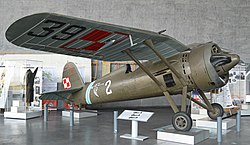PZL P.11
| PZL P.11 | |
|---|---|
 PZL P.11 , exhibited in the Polish Aviation Museum |
|
| Type: | Fighter plane |
| Design country: | |
| Manufacturer: | |
| First flight: |
August 1931 |
| Number of pieces: |
350 |
The PZL P.11 was a single-engine standard fighter designed in Poland from the 1930s.
development
With the young designer Zygmunt Puławski hired in 1928 , the Polish PZL (State Aircraft Works) began building hunting decks with seagull wings. All early production models were powered by Jupiter engines built in Poland. A large number of PZL P.7a fighters formed the backbone of the Polish Air Force . The P.11 was the successor.
When the prototype was ready to fly, Puławski was killed in a plane crash in March 1931 . His successors were Stanisław Prauss and Wsiewołod Jakimiuk.
The first flight of the prototype P.11 / I took place in August 1931, initially with a 384 kW (522 hp) Jupiter IX.ASb. It was not until December 1931 that the P.11 / II followed with a 395 kW (537 hp) Bristol Mercury IVA with a wide Townendring .
After lengthy trials, the P.11a went into series production with the Mercury IVS built in Poland (25 units built). In 1934 visibility for the pilot was improved by installing the engine lower and placing the pilot higher ( P.11c , 175 units built). At the same time, the tail unit and the wings were changed and preparations were made for the installation of a radio and two other machine guns in the wings. However, they were usually not available for installation. 175 machines were produced.
The last production model was the P.11b (50 pieces) for export, which was built in Romania as IAR P.11f (80 pieces). Further developments were planned.
When the war broke out , the PZL P.11 was the standard fighter of the Polish Air Force. In September 1939, twelve P.11c squadrons, each with only two machine guns, took part in the air defense of Poland. They operated without a warning system in chaotic conditions. Nevertheless, with 114 losses of their own, they shot down 126 German aircraft, including nine Messerschmitt Bf 109s and six Messerschmitt Bf 110s . The first Polish, and thus also Allied, aerial victory of this war was achieved by Lieutenant Władysław Gnys with a P.11 on September 1, 1939 at 5:20 am against a Ju 87 of Group I of Stuka Squadron 2. The last PZL- Jäger formed the P.24 family, many variants of which were only built for export.
They were also used by the Germans for training purposes after the attack on Poland ended.
technical description
The P.11c was a stripped shoulder wing aircraft in all-metal construction with a distinctive Puławski wing . The normal tail was also made of metal and was braced. The landing gear was rigid. There was a grinding spur at the stern.
Technical specifications
| Parameter | Data (PZL P.11c) |
|---|---|
| crew | 1 |
| span | 10.72 m |
| length | 7.55 m |
| height | 2.85 m |
| Wing area | 17.90 m² |
| Empty mass | 1147.5 kg |
| Takeoff mass | Max. 1630 kg |
| drive | an air-cooled 9-cylinder radial engine PZL Mercury VIS2 with 645 PS (474 kW) |
| Top speed | 389 km / h at an altitude of 5500 m |
| Rate of climb | 800 m / min |
| Service ceiling | 8000 m |
| Range | normal 670 km max. 810 km at cruising speed |
| Armament | four 7.7 mm MG Wz 33 with 500 rounds each on the sides of the fuselage and hangers for light (12.25 kg) bombs under the wings |
Countries of operation
literature
- Olaf Groehler : History of the Air War 1910 to 1980 , Military Publishing House of the German Democratic Republic, Berlin 1981


